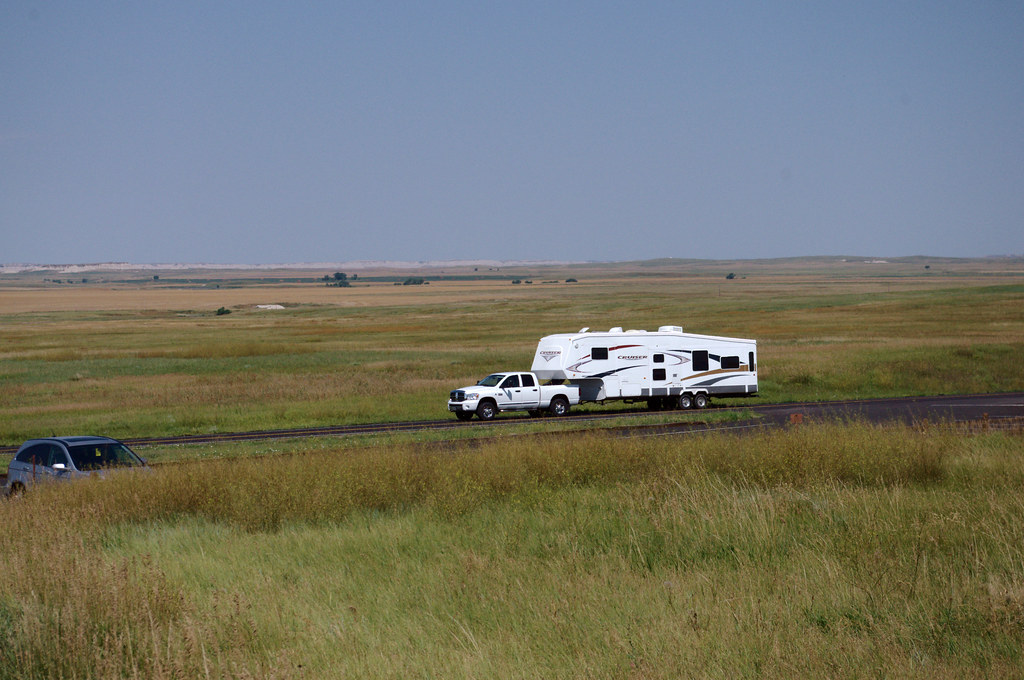Author: Mike Goad
Published: August 9, 2022
Camping and Travel Daily Image No. 47

Dark Skies, Cooke City, Montana, August 13, 2014
Wikipedia
(Accessed August 9, 2022)
Cooke City is an unincorporated community and census-designated place (CDP) in Park County, Montana, United States. As of the 2010 census, it had a population of 75. Prior to 2010, it was part of the Cooke City-Silver Gate CDP.
The community sits northeast of Yellowstone National Park on the Beartooth Highway, which leads east to Red Lodge, Montana, on a scenic route climbing to 10,947 feet (3,337 m) in elevation through the Beartooth Mountains and across the Beartooth Plateau. The town’s chief industry is tourism, which during the winter includes skiing and snowmobiling.
It is named for Jay Cooke, financier of the Northern Pacific Railroad.
Like this:
Like Loading...
Author: Mike Goad
Published: August 8, 2022
Camping and Travel Daily Image No. 46

Crossroads Cruiser fifth wheel on the road in Badlands National Park, South Dakota, August 11, 2014
Crossroads Recreational Vehicles
from 2014 promotional literature
Crossroads towables are great for going on vacation, weekend family trips to the campground or a good way to ease you into the RV lifestyle. Production of Crossroads fifth wheels is located in northern Indiana in the heart of Amish county.
Crossroads RV is a Thor subsidiary that produces travel trailers and fifth wheel RVs in Topeka, Indiana.
Like this:
Like Loading...
Author: Mike Goad
Published: August 7, 2022
Camping and Travel Daily Image No. 45

Martin Lake, next to Bull Trout Campground, Idaho, July 27, 2010
U.S. Forest Service
Boise National Forest
Accessed July 29, 2022
Bull Trout Campground lies adjacent to the 100-acre Bull Trout Lake and 6-acre Martin Lake which offer great fishing from shore or non-motorized boat. The campground offers group sites for that special reunion or company retreat and equestrian sites for the horseback riding enthusiast. Use is high during the summer months and the campsites are usually full on weekends and holidays. The road into the campground is usually not clear of snow until the middle of June, please check with the Lowman Ranger District for current road conditions.
The campground is situated in a mixed-growth forest of Douglas fir and lodgepole pine, which offers partial shade. Summer wildflowers are abundant.
Bull Trout Lake offers excellent canoeing and kayaking opportunities, as the lake is for non-motorized watercraft only. Anglers fish for brook and rainbow trout. A primitive boat ramp is located on the west side of the lake.
Martin Lake is nearby, offering canoeing and fishing. The lake is stocked with rainbow trout.
Many miles of trails can be found in the area, including the 11-mile Warm Spring Trail for hikers. The 35-mile Kirkham Ridge Trail is open to hiking, mountain biking, horseback riding and dirt biking.
Like this:
Like Loading...
Author: Mike Goad
Published: August 6, 2022
Camping and Travel Daily Image No. 44

Stormy weather over the southern end of the Lost River Range at Arco KOA, Idaho, July 2010
As I recall, we got a pretty good blow out of these storm squalls, but not much more than a few drops of rain. Dry conditions are normal for Arco. It’s in a high mountain desert a little over a mile above sea level, with old lava fields to the west, south, and east. It’s only 19 miles to the visitor center at Craters of the Moon National Monument & Preserve. We lived in Arco from 1977 to 1980.
Composite image from three Pentax K10D photos using Autostitch
Like this:
Like Loading...
Author: Mike Goad
Published: August 5, 2022
Camping and Travel Daily Image No. 43

Apache plume blossom, Manitou Cliff Dwellings, Manitou Springs, Colorado, June 14, 2021
Fallugia paradoxa
A member of the rose family, the Apache plume, or Fallugia paradoxa, is a hardy shrub that can grow to 6 feet tall and 6 feet wide. It makes an excellent hedge and grows purplish feathery seeds on the top of its small white flowers.
Manitou Cliff Dwellings
The Manitou Cliff Dwellings are a privately-owned tourist attraction consisting of replica Ancestral Puebloan cliff dwellings and interpretive exhibits located just west of Colorado Springs, Colorado, on U.S. Highway 24 in Manitou Springs. (Wikipedia)
Like this:
Like Loading...






